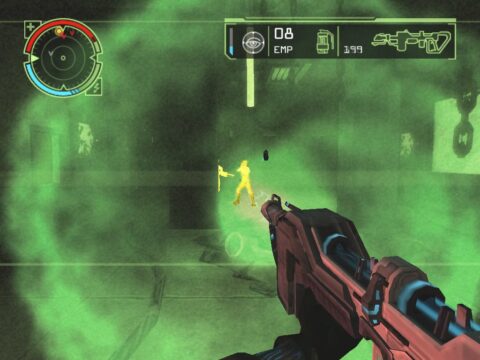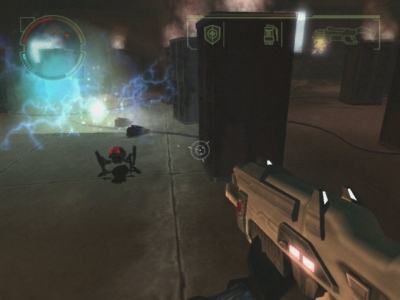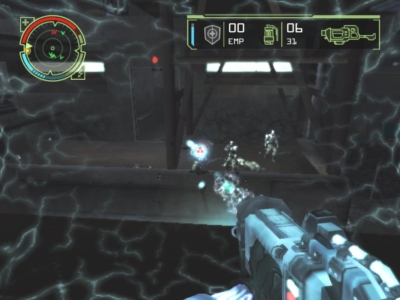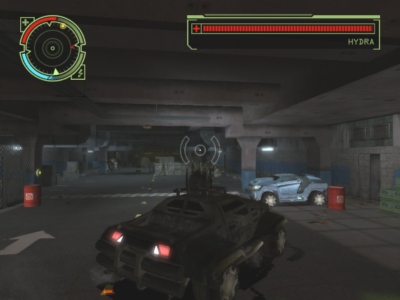
Project: Snowblind
Written by: Rik
Date posted: November 10, 2011
- Genre: Action
- Developed by: Crystal Dynamics
- Published by: Eidos
- Year released: 2005
- Our score: 7
Project: Snowblind began life as Deus Ex: Clan Wars, a proposed multiplayer shooter set in the world of JC Denton et al. Somewhere along the line, though, the decision was made to remove the DX branding to give us this: an action game set in a completely different, albeit extremely similar, universe. Whatever the reasons for the decision, it certainly seems, with the benefit of hindsight, to have been a slightly odd one, especially to us retro-bores who harp on about how great the original Deus Ex was/is at every opportunity, and for whom Project: Snowblind‘s origins in the DX universe are the main reason for tracking it down in the first place.
Still, perhaps unleashing a straight-up action game bearing the series name to a gaming public that considered Invisible War a dumbed-down disappointment might not have been such a good idea after all. In fact, it’s probably best to put Deus Ex to the back of your mind as you approach Project: Snowblind. Otherwise, you risk approaching the game with certain expectations that are unlikely to be met. Yes, Snowblind is sci-fi, and there are nano-augmentations all over the shop, and there are times when it even looks and sounds as if it somehow belongs to the series. But it doesn’t have the same ambitions – this one’s most definitely a linear shooter. And that doesn’t mean it isn’t good, but it certainly isn’t clever.
In Project: Snowblind, you are Nathan Frost, a lowly grunt working for the Liberty Coalition, a kind of futuristic UN, in futuristic Hong Kong. As you might expect, there’s soon some kind of trouble brewing, and inevitably the Coalition represents the world’s only hope. If that sounds vague, it’s because the introduction goes into the very barest of details, giving us only this by way of explanation: ‘A militant regime known as “The Republic” takes advantage of a divided nation, plunging the nation into civil war.’ Which is right up there with The Phantom Menace‘s mysterious ‘taxation of trade routes’.
Anyway, one mission in, and Nathan’s got a problem when, following a scripted act of generic heroism, he finds himself on the receiving end of a large explosion and finds himself reincarnated as a hard-as-nails, technologically-enhanced super-soldier. This is all quite well done, actually – you do the first mission as a human wimp, and then the traumatic life-saving and hammer-and-nails repairs are relayed to you via blurry first-person cut-scenes reminiscent of those in Robocop (and a million other sci-fi films where similar events might have taken place). And in one swift stroke you’re transformed from mere foot-soldier to become the Coalition’s main weapon in the fight against The Republic.
Frost’s nano-augmentations provide the main deviation from an otherwise standard FPS template. In a manner similar to contemporary shooters such as Call of Duty, early levels see you herded through a fairly linear set of urban combat situations with a set of team-mates for whom you’re supposedly responsible, but yet have absolutely no control over. There’s gunfire, explosions and people going ‘argh!’ everywhere, while instructions are barked at you at appropriate intervals when you need to do something specific, like shoot a man who has control of a mounted machine gun and then use that machine gun to kill other men.
Fittingly, you also have plenty of firepower of your own to play with, from the usual pistols, rifles and shotguns, to the more outlandish future-y laser-type things. There’s also more kinds of grenade than you know what to do with, too. The ace up your sleeve is the fact that, as we mentioned, your character is a nano-augmented superman, and so you’re able to call upon an increasing number of special powers, including the ability to see through walls, slow down time, become invisible, and become invulnerable. Obviously, all of these powers only last for a limited time, and they drain power from your bio-cells each time you activate them, so you have to use them sparingly.
Still, they most certainly do add to the feeling that you’re a pretty hard bastard compared to your puny squad-mates, even if some of them are more useful than others. To be honest, once I got the ballistic armour, which basically stops you from taking any damage, I didn’t bother using anything else all that much, and even when your commanding officer orders you to try out a new one, you don’t have to comply with his request – which is a good job, because there’s some kind of lightning-bolt power at the end that didn’t seem to work for me at all. To stop things becoming too easy, though, your enemies can disable your nano-powers by hitting you with EMP weaponry, and by the end of the game you’ll be facing off against Republic soldiers with similar abilities to your own.
There’s generally a feeling of being spoiled for choice, and progress is possible regardless of what your own particular preferences are. In one sense, this is a good thing if you don’t like to think about these things too much, but on the other hand it means you can blunder through without even working out what half of the things in your possession actually do. There are pickups littered throughout every level, and you’ll rarely be short of anything – in fact you’ll only occasionally register exactly what it is you’ve just acquired. Even to a seasoned gamer, who expects to come upon wooden crates full of goodies, it does seem slightly incongruous for there to be quite so much equipment carelessly lying around as you’ll find here.
On a similar theme, the ‘save points’ – yep, no quicksaving here – also seem a little odd, as they come in the form of handy little safe rooms where you go and log onto a computer to save your progress. No explanation is given as to what purpose they serve, sitting smack bang in the middle of an enemy base for you to find, and no-one will ever follow you in there, no matter how many alarms are going off, or how many enemies are pursuing you at the time. (Yes, I know pressing a key to save every 10 seconds isn’t realistic, either, but this just seems quite silly, really).
Brief moments of respite aside, the action comes thick and fast. There are a couple of levels which attempt to bring the pace down slightly, but to be honest you can just ignore the instruction to be quiet and go blasting everything in sight without anything particularly bad happening. Occasionally, there are some fairly cunning things you can do (see Icepick Hacking for more) to bypass certain situations, but generally, it’s run-and-gun all the way, with little cause for too much thought or strategy.
There’s certainly no doubting the quality of the shooting action, but there’s definitely little subtlety. As we’ve already mentioned, there’s little call for you to understand all of the weaponry and gadgetry at your disposal, and even when you’re specifically instructed to use a particular item, you don’t have to. You might consider this quite liberating – especially if you hate being forced to play by the rules of a flawed stealth system, or to use an otherwise useless weapon just because the developers have constructed a contrived situation where you basically have to – but at times, it seems Project: Snowblind doesn’t really mind what you do.
Anyone hoping for plot intricacies is going to be disappointed, too. Don’t, for example, expect any of your colleagues to be suspicious of your new augmentations, or to chide you for being less human. Frost himself (who, by the way, is a giant arsehole with a put-on, trying-too-hard, macho-man voice from the big book of generic action game heroes) also seems to bear few psychological scars, and generally everyone acts as if they’ve just uncovered a walking, talking superweapon that’s going to assure them of victory. It’s here where you’ve really got to put any thought of Deus Ex out of your mind: good and bad are clearly delineated from the start, and pretty much stay constant throughout. (See Frosty and the General for more, and mild spoilerage).

If you get zapped by one of these little bastards, you’ll temporarily be ‘snowblind’. Here, our vision’s returning, but augs are still unavailable.
Still, before we get too negative, it’s worth emphasising that on it’s own terms, Project: Snowblind is a fine shooter, zipping along nicely through 18-or-so levels of action, and building to the traditional FPS crescendo of escaping a building that’s about to self-destruct, via other genre staples such as base infiltration and fighting a boss-battle against an enemy who manages to take several rockets in the face without dying. Standard Republic soldiers aren’t much of a challenge, except for the fact that there’s so many of them, but when you’re up against those with stealth, speed and armour augmentations, things get a little more interesting.
Snowblind’s presentation deserves praise, too. Although level sizes are restricted by the game’s PS2/Xbox roots, the game generally looks fantastic. Smoky neon darkness is the staple of this kind of near-future sci-fi, and it’s been done before, of course, but the overall atmosphere created here is impressive. Some rather nice graphical effects come into play when you use Frost’s augs, too, particularly the blurry shield that comes across the HUD when you engage the ballistic armour. Background music is effective but unobtrusive, while the acting (Frost aside – thankfully he only talks in cut-scenes) is inoffensively generic – and coming from someone notoriously irritable about such things, this should probably be taken as a compliment, too.
All-in-all, Project: Snowblind represents an involving but undemanding weekend’s fun. It’s not the longest game in the world, so if such things bother you then prepare to be bothered, but I’d argue it’s roughly as long as it needs to be – for a high-tempo action game, it seems about right, and while I’m sure the developers could have added a couple of hours or so of dull padding, I’m glad that they didn’t. The feeling that there’s some potential that hasn’t been realised here may linger after the end credits roll, but until that point you’ll be too busy blasting bad guys and being carried on by the relentless action to care.





 Posts
Posts
What absolutely killed this game for me is the slight but non-optional auto-aim. I don’t even use auto aim when I play FPSes on a console, let alone PC.
November 10, 2015 @ 9:58 pm
It’s been a while, but I’m not sure that was something I noticed. Perhaps I just need all the help I can get!
November 11, 2015 @ 8:18 am